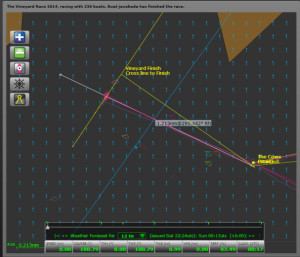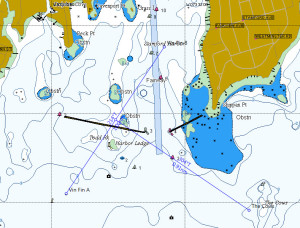
When WINSTON rounded The Cows and headed for the finish line at the end of The Vineyard race I smiled.
WINSTON was headed for the line at an angle.
I was going to do the same thing.
Instead of taking the shortest route to the finish, we were taking the quickest route.
It’s all about VMC
Velocity Made good on/along Course (VMC) is a metric that sounds really cool until you try to use it. Then three questions arise:
- What course are we talking about?
- How do we calculate the VMC heading?
- Once we have the VMC heading, does it do us any good?
Answering those questions in the general case can get intricate. I am sure we will have more than one future post on the subject.
In the specific case at hand, however, these questions are easy to answer.

The Course is the direction of a line from The Cows to the Finish Line that is perpendicular to the Finish Line. There are two easy ways to find that heading:
- Use the divider tool to measure the bearing from Vin Finish B to Vin Finish A. Then add 90° to that value.
- Use the divider tool to trace the final course leg shown in the SOL Client. Then use the value shown by the divider tool.
Either way I get about 304°T for that rhumb line course.
To calculate the VMC heading we need access to the boat’s polar table, the course (above), and the TWD and TWS expected at The Cows when we round (rounded values from the screenshot above). If we want to measure time to finish, we will need the distance along our selected course.
We could use WX Inspector for this calculation. And 76T’s blog presents a great graphic approach.
But lets use Kroppyer’s SPINNACER tool to calculate a VMC heading in this situation. I prefer it because of its efficient UI and its small screen footprint.

The base case is heading toward the finish line along the rhumb line of (304°T).
After I selected the right polar and entered the required data, SPINNACER gave me an estimated time to finish of 6m28s if I sailed down the rhumb line of 304°T.

Calculating the VMC heading was a simple matter of ‘checking’ the Best VMC checkbox. That yielded a COG of 195.475°, which I rounded to 195.5°T to keep my High School physics teacher happy regarding significant digits.
The new heading meant I needed to adjust the distance to the finish − 0.91nm in the base case became 0.92nm in the VMC case. After that change, the new ETF was 6m18s − a 10 second improvement over the base case.
In a close race like this, that could mean passing a boat between The Cows and the finish.
Clearly, WINSTON wasn’t taking any chances!

Hi Solfans,
I approached this problem Javakeda describes as follows.
1/ I downloaded the VBA code for a few Excel UDF’s from a site I found trawling the interweb called Great Circle Navigator by Ed Williams (http://williams.best.vwh.net/index.htm ).
2/ Well before the finish I enter the lat and lon coords of the finish extremities A and B into a standard spreadsheet that I made that uses these UDF’s.
3/ As I round the last mark or get to an on course position where I start to wonder what end of the line should I aim for, I copy and paste bonk’s position and local weather (TWS, TWD) over from Brainaids into this spreadsheet.
4/ The spreadsheet now calc’s the course and distance to each end using Ed’s UDF’s and to any position along the line between A and B.
5/ The spreadsheet also picks up the speed bonk will do along each course from an interpolatable polar BS table as determined by TWA (I know the CCs and I know TWD) and TWS.
6/ BS x distance tells me how long it is going to take. The spreadsheet immediately tells me whether it is quicker to aim for A, B or midline. If say A is best, I then change the midline option to say 0.3 from A and see if this is better again or worse. Etcetera. A few manual iterations and the problem is solved.
7/ But in the Vineyard, I must confess, although with the very short run in to the line there was an ideal opportunity to make this pay, I sailed bonk in SOP, just watching Dingo!